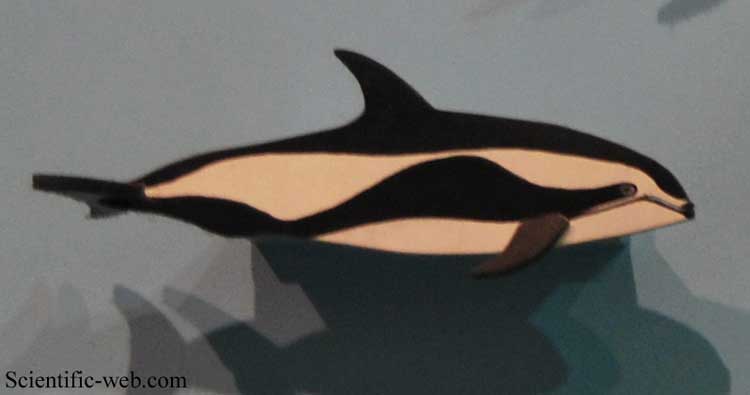Lagenorhynchus cruciger, Photo: Michael Lahanas Cladus: Eukaryota Name Lagenorhynchus cruciger (Quoy and Gaimard, 1824) References * Lagenorhynchus cruciger on Mammal Species of the World. Vernacular names ---------------- The Hourglass Dolphin (Lagenorynchus cruciger) is a small dolphin found in Antarctic and sub-Antarctic waters. Historically, the dolphin has rarely been seen. It was first identified as a new species by Qouy and Galmard in 1824 from a drawing made in the South Pacific in 1820. It is the only cetacean to have been widely accepted as a species on eye accounts alone 1. Indeed by 1960, despite decades of whaling in the Southern Ocean, only three specimens had been brought to the attention of scientists. Even now only 6 complete and 14 partial specimens have been examined. Further information has been obtained from 4 strandings and boats which have deliberately set out to observe the dolphins in areas rarely otherwise visited by ships. Though it is traditionally placed in the genus Lagenorhynchus, recent molecular analyses indicate that the Hourglass Dolphin is actually more closely related to the dolphins of the genus Cephalorhynchus. The Hourglass Dolphin is coloured black and white and for this reason was colloquially known by whalers as the "sea cow". On each flank there is a white patch at the front of the dolphin, above the beak, eye and flipper, and a second patch at the rear. These two patches are connected by a thin strip of white, creating, loosely speaking, an hourglass shape and hence the common name of the dolphin. The scientific name cruciger is Latin for "cross-carrier". This refers to the area of black colouration on the body, which, viewed from above, vaguely resembles a Maltese cross or cross pattée. In its usual range the dolphin is easily identifiable. Only the Southern Right Whale Dolphin is of comparable size and found as far south. The Right Whale Dolphin does not have a dorsal fin, so the two species are trivially distinguished from one another. The fin varies from one individual to another quite considerably. Generally speaking it is tall and curved, and the curve may be particularly pronounced in older animals. A fully grown adult is about 1.8 m/5.9 ft length and weighs 90-120 kg/198-264.6 lbs. Males are probably slightly smaller and lighter than females (from a sample size of eight specimens). Population and distribution The range is circumpolar from close to the Antarctic ice pack to about 45°S. The most northerly confirmed sightings were 36°S in the South Atlantic Ocean and 33°S near Valparaíso, Chile, in the Pacific. Sightings have been made most commonly from the south of New Zealand around the South Shetland Islands and off Tierra del Fuego, Argentina. The species is unlikely to be particularly densely populated close to these lands. One survey estimated that there was a minimum of 140,000 individuals alive today. Behaviour Hourglass Dolphins tend to move in groups of about 5-10. One International Whaling Commission study recorded a group of 60. They share feeding grounds with other cetaceans such as Sei, Pilot, Bottlenose and Minke Whales and Southern Right Whale Dolphins. They are regularly seen with Fin Whales. In fact, whalers hunting these much larger whales used Hourglass Dolphins as "look-outs" to aid them in their hunt. Hourglass Dolphins are keen bow-riders. Examinations of the stomach contents of the few analysed specimens indicated the it eats various (unrecorded) types of squid and small fish. References 1. ^ Hammond, P.S., Bearzi, G., Bjørge, A., Forney, K., Karczmarski, L., Kasuya, T., Perrin, W.F., Scott, M.D., Wang, J.Y., Wells, R.S. & Wilson, B. (2008). Lagenorhynchus cruciger. In: IUCN 2008. IUCN Red List of Threatened Species. Downloaded on 24 March 2009. Database entry includes a brief justification of why this species is of least concern * LeDuc, R.G., Perrin, W.F., Dizon, A.E. (1999). Phylogenetic relationships among the delphinid cetaceans based on full cytochrome b sequences. Marine Mammal Science 15, 619–648. Source: Wikispecies, Wikipedia: All text is available under the terms of the GNU Free Documentation License |
|


